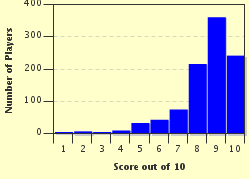Quiz Answer Key and Fun Facts
1. You're over half-way through your adventure novel when you come across the following scene and dialogue:
"Ehhhh (chomp chomp), slow down a second, Doc. Would ya mind helpin' out with some directions? My mansoivent Passepartout and I need to find New Yawk (that's right, Doc! NEW YAWK!) harbor to catch a ship to London. Got a big bet to win! 20,000 pounds! Nahhh, not money, ya palooka, (chomp chomp) carrots! I don't know where we are, but it sure ain't New Yawk!"
"Arriba! Arriba! �ndale! �ndale! Hola, Senor! Si, you are in Mexico hermoso! Now, I must go! Adios, amigos! Arriba! Arriba! �ndale! �ndale!"
"Mexico! Passepartout, ya ultramaroon! I told ya we shoulda taken that left toin at Albuquoique!"
Okay, my 'Looney' is Bugs Bunny (with a guest appearance by Speedy Gonzales), but can you name the character he's replacing?
2. You're reading a classic romance novel about a horrible time in America's past, and have come to identify with the trials and tribulations of the beautiful fiery heroine and her darkly handsome 'scalawag' of a husband. On the edge of your seat, your heart breaks when she cries out to him "...if you go, where shall I go? What shall I do?" Then, your image of the scoundrel shatters when he replies "Well boll, I say boll my weevil! Frankly, I say frankly my dear, I don't give, I say I don't give a cock-a-doodle-doo!"
My 'Looney', I say, my 'Looney' may sound familiar, but who is my literary character?
3. "N-n-no, your w-worship, stop! St-stop, my b-b-brave knight! Th-th-those are not g-giants! Th-they are just windmi-windmi-windmi-machines! (Sounds of an off-page crash and a horse whinnying) Oh-oh! Never m-mind!"
Well, I've given you my best Porky Pig impression; was it enough to figure out his character?
4. It's late at night, and you're catching up on the adventures of your favorite super-sleuth. You can even picture him in your mind's eye; his cloak draped over his shoulders, puffing on his pipe as he searches for clues with his over-sized magnifying glass. Yet, for some reason, you see him wearing not his traditional 'deerstalker' hat, but a large hunting cap. Suddenly, the literary version of the 'fourth wall' crumbles as he turns to you and whispers "Shhhhhh! Be vewy, vewy quiet! I'm hunting Pwofessor Mowiawty! Hahahahaha!"
From that short monologue, you may have deduced the name of my 'Looney', but what character does the trail lead you to?
5. While reading a high-seas adventure novel, you become very familiar with a certain feisty (and recently diagnosed with OCD) sea captain and his frequent temper tantrums. You read one such tirade as follows: "Be you the mean critter that's a-hankerin' for a heap of trouble? Towards thee I roll, thou all-destroying but unconquering shark-livered varmint! To the last I grapple with thee, ya danged ol' fin flappin' flounder! From Hell's heart I stab at thee, ya no good bush-whackin' barracuda! For hate's sake I spit my last breath at thee, ya derned shovel-nosed mackerel! Ha! Missed me again, ya hammerhead halibut!"
Wow! Looks like there might be two 'Looneys' here! Can you 'fathom' their identities?
6. Ah! Judging by your book, I see you like a little romance mixed in with your swordplay! Do you mind if I read over your shoulder? Oui? Merci beaucoup!
"Alas, My sweet Constance! My friends, they await me and I must go (Un Moment, Porthos! I must stoke zee furnace of love!). Au revoir, my butterduck. Sweeting is such part sorrow (Patience, my dear Athos! Mon Dieu!)! Zee moon, zee June, zee spoon! Another kiss, my melon baby collie? C'est l'amour, c'est toujours (Sacre Maroon, Aramis! Zee post of honor can wait, no?)! Constance, mon cherie...Constance? Where did you go? Where are you, my little Stutz-bearcat of love? Zee cabbage does not run away from zee corn-beef! Ahhh! You know, mes trois amis, I may have overstoked zee furnace...but vive l'amour!"
So, mon ami/amie, who is zee mystery literary character?
7. How about a 'twofer'?
You're reading about the somewhat unusual circumstances of a certain English doctor. In the scene before you, the doctor is composing a letter, and you are able to read its contents as such:
"I have compweeted my formuwa, and I am pwepawing to dwink it and study the wesuwting effects. Here we go!...
...Stwange. I don't feew any diffewent...but my hands! My goodness, are they tuwning into cwaws? The miwwor! I need to wook in the miwwor."(The doctor looks at his reflection, and then at you.) "I tot I taw...
...Mwaahahaha! (evil laugh) Thufferin' Thucotash, I'm thtarving! Hmmmmm. Hello there, little fella! You..look..deeeelithious!...
...I did! I did taw...Mwaahahaha!"
My two 'Looneys' are well-known adversaries, but the relationship between the two literary characters is a little more complex, as you can tell. What are their names?
8. Let's do another duo.
This chapter in your latest book transports you to a eerie laboratory set within a sinister-looking castle, where a wild-eyed scientist is putting the finishing touches to his latest experiment. You read along as he mutters:
"This time, I shall not fail! The new equipment has arrived and has been properly installed. The ACME 'New-and-Vastly-Improved Anti-Fry' circuit breakers are wired into the ACME 'Significantly-Better Mega-Bolt' lightning rods. The ACME 'Lifetime-Guarantee Never-Bust' straps are secured to the ACME 'No-Worries-Tonight Giganto-Hold' operating table. The ACME 'Superior-Quality Insta-Zap' electrodes and the ACME 'Ultra-Industrial Excito-Brain' cerebral stimulators are primed. I just need to switch on the ACME 'Way-More-Power-Than-Necessary Super Turbo' generator, and...LIFE! Give my creation LIFE!" (you can imagine the sounds and flashes of violent electric energy and small explosions, as well as the smell of burning copper)
"It's ALIIIVE! Speak, my creation...SPEAK!"
"BEEP BEEP!"
"OOOoohhhh NOOooooo!"
And again, Wile E. Coyote's plans are foiled by the Roadrunner. Which literary characters are they portraying?
9. I'm going to be a little creative on this question in terms of the definition of a 'character', but I just couldn't help it, so bear with me.
You've just started a well-known and much-loved children's fantasy novel, and are already sharing the anxiety of the young heroine as apparent doom seems to rapidly approach her, her little dog, and the farmhouse she shares with her aunt and uncle. She states: "My, I've seen some pretty fierce storms here in Kansas, but I've never seen one like this before! It's all twisty and turny, and I...I think I see legs...and claws...and teeth, oh my! And is that storm actually SPITTING and GROWLING at me? Quick, Toto, we have to go warn Auntie Em and Uncle Henry!"
You've probably figured out the book, and even the identity of the young lass, but how about my 'Looney' and the replaced 'character'?
10. Not forgetting the title of this quiz, slip on your reading glasses and see if this 'daffy' monologue rings a familiar bell:
"Alright, enough ith enough! What'th the deal with the thcript changes all the thuddnen? Firth, I had to eat thlop and pick pocketh with a bunch of dirty kidth, but did I complain? No! Then, I get a new thcript! Ghosths woke me up every night rattling their chainth! Hear any gripth from me? Nope, not a whithper, because I'm a profethional! Now another new thcript? Who the Dickenth ith running thith railroad, anyway? Hmmmmmm (flips through pages and reads)...'It ith a far, far better thing that I do blah blah; it ith a far, far better retht that I go blah blah...' Ok, nithe ending, I can uthe the retht and it thoundth like I'm the hero for a change! But I don't get the girl, huh? Go figure! And who'th thith 'Guillotine' character I meet up with?...It'th...it'th a WHAT?...It doeth WHAT? I...I...Ohhhh, you're...you're dethpicable!"
Ok, I might have laid Daffy's 'lithp' on a little thick (but in his own words "Tho thue me!"), yet it shouldn't be too hard to figure out which Dickens' character's dressing room he'll 'be-heading' (groan) to for his last script, should it?
Source: Author
doorsfan58
This quiz was reviewed by FunTrivia editor
looney_tunes before going online.
Any errors found in FunTrivia content are routinely corrected through our feedback system.

